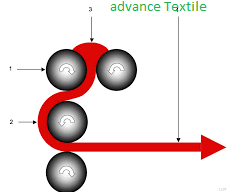Introduction
Not
suitable for wearing without finishing the raw fabric. So raw fabrics/garments
need a different kind of finishing.
The woven fabric finishing process
The
cotton fabrics woven in its loom-state not only contain impurities with warp
size but also require further treatment to develop its full textile potential.
Furthermore, it can get substantial additional value by applying one or more
finishing processes.
Desizing process
The
process of removing sized elements from warp yarn after the textile fabric is called
desizing. The desizing agent determines what is involved with the impregnation
of the fabric with the agent in order to degrade or dissolve the size material
and ultimately allow the degraded products to be washed.
Scouring process
Scouring
is the process of removing natural (oil, wax, fat, glue, etc.) as well as impurities (during fabrication) to produce hydrophilic and clean textile
materials. This is a very important process of wet processing. In other words, Scouring
is a chemical washing process on a cotton cloth to remove natural wax and
non-fibrous impurities (e.g. seed fragments) from the fiber and any added soil
or dirt. Scouring is usually carried on iron vessels called kiers. The fabric
is boiled in an alkali, which forms a soap with free fatty acids (saponification).
Kier is usually closed, so a solution of sodium hydroxide can be boiled under
pressure by excluding oxygen which reduces the cellulose of the fiber.
Bleaching process
Bleaching
is a process in which the natural colors of textile fibers are removed in order
to achieve a white color for the development of the actual color. It improves
whiteness by removing natural color and remaining trace impurities from cotton;
the degree of bleaching required is determined by the required whiteness and
absorption.
Mercerizing process
Mercerization
is the treatment of cellulose fabrics and yarns, mainly cotton and textile
finishing for discipline, which improves dyes and reduces tear strength fabric
shrinkage, and provides a silky shine. The process was developed by John Mercer
in 1844, who applied a 55-65 ° Twaddle scale (20-30%) sodium hydroxide solution
for cotton washing. Here cotton is treated with sodium hydroxide. Cellulose is
converted to hydrate. A caustic soda concentration of 20-26% is used. Effective
mercerization requires the use of wetting agents.
Singeing process
In the textile industry, loose fibers scattered on the surface of textile
materials are equipped removed them. When done on cotton fabrics, it results
in reduced durability, better dyeing properties, improved reflection, no frosty
appearance, a smoother surface, more precision in printing, improved visibility
of fabric structure, less peeling, and reduced pollution resulting in fluff and
debris removal. The process usually allows the fibers stretched over a flame of
gas to ignite on either side of the fabric on one or both sides. Cellulose
fibers such as cotton are easily singed because the extensible fibers are
burned in light ash which is easily removed. Thermoplastic fibers are harder to
singe because they melt and form hard residues on the fabric surface.
Raising process
Is
raising another finishing process. During emergence, the fabric surface is
treated with sharp teeth to lift the surface fibers, resulting in hairiness,
softness, and warmth, such as a flannel.
Calendaring process
Calendaring
of textiles is a finishing process used to smooth, coat, and smooth any
material. With textiles, the fabric passes through calendar rollers at high
temperatures and pressures. Calendaring peacock-like fabrics are used to create
its aqueous effect and cambric and some types of satin. To prepare for calendaring,
the fabric is folded lengthwise through the front or face, and sewn along the
edges. The fabric can be folded together over the entire width, but not as
often as it is difficult. The fabric is then rolled through rollers that polish
the surface and make the fabric smoother and more lustrous. High temperatures
and pressures are used as well. The fabrics that go through the calendaring
process look thin, glossy, and papery.
 |
| Calendering process |
Sanforizing process
Sanforization
is a process that is mainly applied to cotton fabrics and textiles made from
natural or synthetic fibers. It is seen after washing that the woven fabric is
a method of stretching, shrinking, and fixing in both length and width before
cutting and reducing the fabric shrinkage. The cloth is continuously fed into a
Sanforizing machine and moistened with water or steam. Fabrics and articles
made from it may be labeled as a certain shrink-proof value, for example, below
1%.
Dyeing process
Dyeing
is the process of applying dyes or pigments to textile materials such as fibers,
yarns, and fabrics in order to achieve the desired color. Dyeing is usually
done in a special solution containing dyes and certain chemical elements.
Pigment molecules are fixed with fibers by binding as factors controlling
absorption, expansion, or temperature, and time. The bond between the dye
molecule and the fiber can be hard or weak depending on the dye used. Cotton is
colored with a variety of dyes, including VAT dyes and modern synthetic
reactive and direct dyes.
Printing process
Textile
printing is the process of applying fabric dye to specific patterns or designs the
color of properly printed fabrics is bound with fiber, to prevent washing and
abrasion. Textile printing is related to dyeing but in the case of proper
dyeing, the whole fabric is evenly covered with one color, whereas in printing
one or more colors are applied only to specific parts and to sharply defined
patterns. In printing, wooden blocks, stencils, engraved plates, rollers, or silkscreens
can be used to color fabrics. The colors used in printing are thickened by the
capillary attraction to spread the color beyond the boundaries of any pattern
or design.
 |
| Printing process |
Conclusion
Energy
consumption in the form of water and electricity is relatively high, especially
in processes such as washing, de-sizing, bleaching, rinsing, dyeing, printing,
coating, and finishing. In the textile industry, the main part of the water is
used for the wet processing of textiles. About 25 percent of the total textile
production energy is used in dyeing such as fiber production, spinning,
twisting, weaving, weaving, garment manufacturing, etc. About 34 percent of
energy is spent on spinning, 23 percent on weaving, 38 percent on chemical wet
processing, and five percent on miscellaneous processes. Electricity in
rotation and weaving predominates in consumer patterns, on the other hand, thermal energy is the main reason for chemical wet processing.








0 Comments